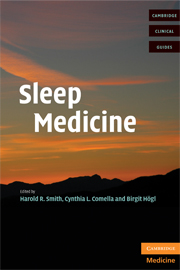Book contents
- Frontmatter
- Contents
- List of contributors
- Foreword
- SECTION 1 NORMAL SLEEP
- SECTION 2 SLEEP DISORDERS
- 3 Parasomnias
- 4 Circadian rhythm disorders
- 5 Excessive somnolence disorders
- 6 Insomnias
- 7 Restless legs syndrome and periodic limb movement disorder
- 8 Sleep apnea (central and obstructive)
- SECTION 3 SLEEP IN SPECIALTY AREAS
- Index
- References
7 - Restless legs syndrome and periodic limb movement disorder
from SECTION 2 - SLEEP DISORDERS
Published online by Cambridge University Press: 08 August 2009
- Frontmatter
- Contents
- List of contributors
- Foreword
- SECTION 1 NORMAL SLEEP
- SECTION 2 SLEEP DISORDERS
- 3 Parasomnias
- 4 Circadian rhythm disorders
- 5 Excessive somnolence disorders
- 6 Insomnias
- 7 Restless legs syndrome and periodic limb movement disorder
- 8 Sleep apnea (central and obstructive)
- SECTION 3 SLEEP IN SPECIALTY AREAS
- Index
- References
Summary
Clinical features
Restless legs syndrome
The most characteristic features of the restless legs syndrome (RLS) are uncomfortable sensations in one or more – usually lower – limbs, associated with an urge to move the affected limbs. Those sensations vary widely in severity from merely annoying to significantly unpleasant. It is occasionally difficult for the individual to express the discomfort that is caused by these sensations. Whereas some individuals with RLS describe them as uncomfortable and inside the leg, others speak of pain, pulling, burning, tearing or creepy-crawly sensations, “like ants crawling” or an electric current. All sensations are accompanied by an irresistible urge to move, described as “focal akathisia.”
Symptoms typically begin or worsen during periods of rest or inactivity, such as lying or sitting, e.g., when watching television or trying to fall asleep in bed. Whenever the person is forced to sit still, whether this is at the cinema, in the theatre, or on a long-distance flight, discomfort increases. In moderately and severely affected individuals this may lead them to avoid those precipitating situations, and it significantly influences their quality of life.
Symptoms of RLS demonstrate a circadian pattern, with a maximum of severity in the evening and at night. Disturbance of sleep onset and frequent awakenings at night with difficulty returning to sleep are therefore clinical features of moderate to severe RLS. Many individuals with RLS may initially complain about sleep disturbances or increased daytime sleepiness and report specific RLS symptoms when directly asked.
Keywords
- Type
- Chapter
- Information
- Sleep Medicine , pp. 113 - 128Publisher: Cambridge University PressPrint publication year: 2008
References
- 1
- Cited by



